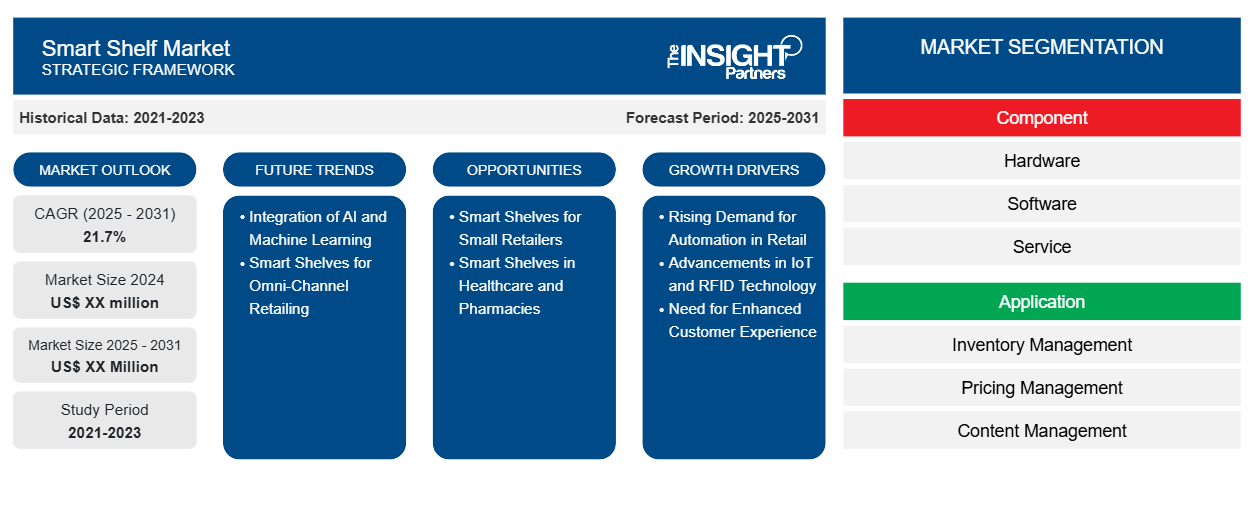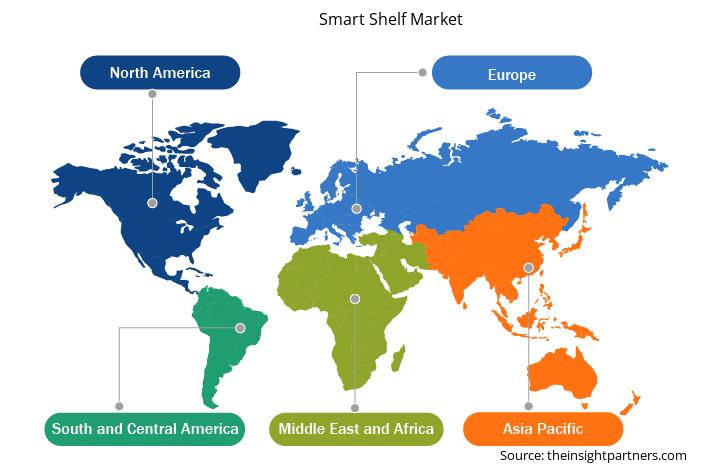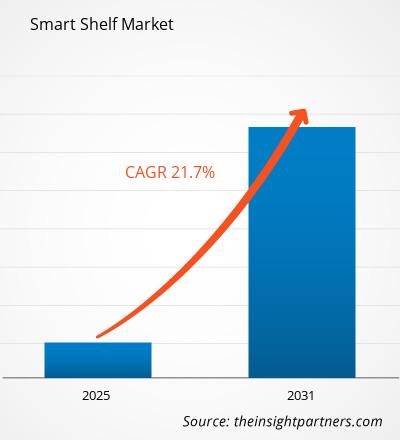预计智能货架市场在 2025 年至 2031 年期间的复合年增长率为 21.7%,市场规模将从 2024 年的 XX 百万美元扩大到 2031 年的 XX 百万美元。
本报告按组件(硬件(物联网传感器、RFID 标签和阅读器、电子货架标签、摄像头)、软件、服务)和应用(库存管理、定价管理、内容管理、货架图管理)进行细分。全球分析进一步细分为区域和主要国家。报告以美元为单位,列出了上述分析和细分市场的价值。
报告目的
Insight Partners 发布的《智能货架市场》报告旨在描述智能货架市场的现状和未来增长趋势、主要驱动因素、挑战和机遇。该报告将为各业务利益相关者提供洞察,例如:
- 技术提供商/制造商:了解不断变化的市场动态并了解潜在的增长机会,使他们能够做出明智的战略决策。
- 投资者:对市场增长率、市场财务预测以及整个价值链中存在的机会进行全面的趋势分析。
- 监管机构:规范市场政策和警察活动,旨在最大限度地减少滥用行为,维护投资者的信任和信心,维护市场的完整性和稳定性。
智能货架市场细分
成分
- 硬件
- 软件
- 服务
应用
- 库存管理
- 定价管理
- 内容管理
- 规划图管理
定制此报告以满足您的要求
您可以免费定制任何报告,包括本报告的部分内容、国家级分析、Excel 数据包,以及为初创企业和大学提供优惠和折扣
智能货架市场:战略洞察

- 获取此报告的顶级关键市场趋势。此免费样品将包括数据分析,从市场趋势到估计和预测。
智能货架市场增长动力
- 零售业自动化需求不断增长:随着零售商寻求精简运营、提高效率,智能货架技术正变得越来越重要。这些解决方案有助于实现库存跟踪、产品摆放和实时库存更新的自动化,从而减少人工操作和人为错误。这种自动化需求推动了智能货架在零售环境中的普及。
- 物联网 (IoT) 和射频识别 (RFID) 技术的进步:物联网 (IoT) 和射频识别 (RFID) 技术的发展是智能货架市场的重要驱动力。这些技术能够实现实时库存跟踪、增强产品可视性以及监控货架状况,从而改善货架管理、提升客户体验并降低运营成本。IoT and RFID Technology: The growth of the Internet of Things (IoT) and Radio Frequency Identification (RFID) technology is a significant driver for the smart shelf market. These technologies enable real-time inventory tracking, enhanced product visibility, and the ability to monitor shelf conditions, leading to improved shelf management, better customer experiences, and reduced operational costs.
- 提升客户体验的需求:零售商越来越注重提升客户体验,以保持竞争力。智能货架通过提供实时产品信息、促销和库存更新,提供动态、个性化的购物体验,从而更有效地吸引和留住消费者。
智能货架市场未来趋势
- 人工智能与机器学习的融合:智能货架市场的未来将见证人工智能 (AI) 与机器学习 (ML) 算法的融合,以增强库存管理。这些技术将实现预测分析,使零售商能够实时预测库存水平、客户偏好和趋势,从而进一步优化货架管理并改善销售预测。
- 智能货架助力全渠道零售:随着零售业向全渠道模式转型,智能货架与线上平台的整合将更加重要。智能货架将促进店内库存与线上库存的无缝集成,确保准确的库存水平,更好地协调线上线下门店,并提升线上和线下购物环境中的顾客满意度。
智能货架市场机遇
- 面向小型零售商的智能货架:虽然大型零售商已开始采用智能货架技术,但中小企业 (SMB) 仍是一个尚未开发的新兴市场。我们有机会打造专为中小企业设计的经济高效、可扩展的智能货架解决方案,帮助他们优化库存管理、提升客户体验,并与大型零售商竞争。
- 医疗保健和药店的智能货架:除了传统的零售环境外,医疗保健和药店也迎来了实施智能货架解决方案的新兴机遇。智能货架可以协助管理药品,确保药品妥善储存,并有助于监控药品有效期。这为进入一个对精准度和效率要求极高的新兴领域提供了独特的机会。
智能货架市场区域洞察
Insight Partners 的分析师已详尽阐述了预测期内影响智能货架市场的区域趋势和因素。本节还讨论了北美、欧洲、亚太地区、中东和非洲以及南美和中美洲的智能货架市场细分和地域分布。

- 获取智能货架市场的区域特定数据
智能货架市场报告范围
| 报告属性 | 细节 |
|---|---|
| 2024年的市场规模 | XX百万美元 |
| 2031年的市场规模 | XX百万美元 |
| 全球复合年增长率(2025-2031) | 21.7% |
| 史料 | 2021-2023 |
| 预测期 | 2025-2031 |
| 涵盖的领域 | 按组件
|
| 覆盖地区和国家 | 北美
|
| 市场领导者和主要公司简介 |
|
智能货架市场参与者密度:了解其对业务动态的影响
智能货架市场正在快速增长,这得益于终端用户需求的不断增长,而这些需求的驱动因素包括消费者偏好的演变、技术进步以及对产品优势的认知度的提升。随着需求的增长,企业正在扩展产品线,不断创新以满足消费者需求,并抓住新兴趋势,从而进一步推动市场增长。
市场参与者密度是指特定市场或行业内企业或公司的分布情况。它表明特定市场空间内竞争对手(市场参与者)的数量相对于其规模或总市值而言。
智能货架市场的主要运营公司有:
- SES-Imagotag
- 普赖斯
- 特拉克斯
- 艾利丹尼森
- 三星
- 电子墨水
免责声明:以上列出的公司没有按照任何特定顺序排列。

- 获取智能货架市场主要参与者概览
主要卖点
- 全面覆盖:报告全面涵盖了智能货架市场的产品、服务、类型和最终用户的分析,提供了整体概况。
- 专家分析:本报告基于对行业专家和分析师的深入了解而编写。
- 最新信息:该报告涵盖了最新信息和数据趋势,确保了业务相关性。
- 定制选项:此报告可以定制以满足特定客户要求并适合业务策略。
因此,智能货架市场研究报告有助于引领解读和理解行业现状及增长前景。尽管存在一些合理的担忧,但本报告的总体优势往往大于劣势。
- 历史分析(2 年)、基准年、预测(7 年)及复合年增长率
- PEST和SWOT分析
- 市场规模、价值/数量 - 全球、区域、国家
- 行业和竞争格局
- Excel 数据集
近期报告
客户评价
购买理由
- 明智的决策
- 了解市场动态
- 竞争分析
- 客户洞察
- 市场预测
- 风险规避
- 战略规划
- 投资论证
- 识别新兴市场
- 优化营销策略
- 提升运营效率
- 顺应监管趋势




















 获取免费样品 - 智能货架市场
获取免费样品 - 智能货架市场